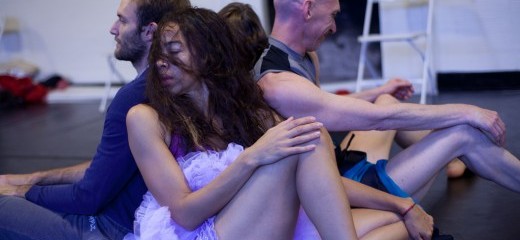
Photo: Tobin Rothlein
The Unbearable Weight of She
by Carolyn Merritt
Black marley bifurcates the white room, lined by chairs on either side, transforming the dance floor into a catwalk, The Crane Arts Old School into a fashion show for Miller Rothlein’s Forbidden Creature Virgin Whore. One by one, the dancers strut before us, establishing fairytale characters that come to life and implode: Paul Struck’s Forbidden Creature, the long-limbed “unfuckable She”* in black halter and wrap pants slit up to hip flexors, eyes aglow beneath blue, green and white lashes; Chandra Moss’ Domestic Goddess, the statuesque, purple-tutued ballerina with pearl earrings and tip-toe walk; Dana Pleakis’ Virgin Whore, of the long blond tresses (all the better to stroke coyly), her red bodice tempered by a sweet pink ballet skirt; and Beau Hancock’s Everyman, the macho Prince Charming who colonizes everything around him with swagger and a whole lot of suspender snapping.
In a twist on Cinderella, Hancock wrestles two silver slippers from his crotch for Moss. The two dance a delicate pas de deux that escalates into tangoesque struggle, until Moss drags him away on her back. Later, Moss unearths a plastic babydoll, feather duster, pastries and a serving tray from under her costume. Unburdened of
"the problem that has no name" the Domestic Goddess lets her hair down, and appears alternately drunk and angry for the remainder of the piece.
Pleakis twirls about, bats eyelashes, cocks head, caresses cheek, and tends to those locks. Eyes on Hancock in back attitude turn after turn, she unveils power dynamics in the simplest of dance’s principles – the spot. Calling her bluff, Hancock pins her against the wall, his face in her crotch as she stares blankly out. Stripped to red skivvies, crumpled to the floor, Pleakis sheds her Virgin skin for Whore body, as Everyman walks smugly away.
A bird-like temptress, Struck accentuates deep side lunges with ever-undulating appendages, beckoning us all into hypnosis like a wicked queen should. Rather than transgressive or liberating, here the male dancer as female outsider seems to reinforce certain stereotypes: that power necessitates “masculinity” and that “masculine” women are ultimately not real women. Similarly, Hancock’s solo reduces masculinity primarily to caricature. At turns stunning and others unconvincing, Hancock shifts from ballet prince – executing perfect tours en l’air – to “macho man,” as he shakes his butt, waves his fist, scuttles in second-plié and doesn’t let us forget his pants need holding up.
The limitations of their characters exposed, they rehash and swap signature gestures – cupping breast, exposing crotch, caressing cheek – and confront Everyman as an ensemble. Tumblesaulting, they nest like Russian dolls, one lap begetting another, only to roll out into the catwalk, ending as one creature with multiple arms, legs, feet, butts, hands, breasts, heads.
-------------------
Miller Rothlein’s 2013/14 season (their 10th) is entitled There All Along. In their season brochure, and in the FCVW program, they invite viewers to “[get] up close and personal” and to “take the time... to see things we might not have noticed before.” I have admired their work in the past for its conceptual and technological heft, and for choreographer Amanda Miller’s mesmerizing performances. FCVW’s dancers have serious chops. They seamlessly move through vocabulary that is balletic, athletic and modern. But FCVW struck me as both narrow and dated for its ambitions.
The text accompanying FCVW, penned by illustrator and dramaturge Kristin Kest, is a lengthy thesis on the enduring power of gender norms via archetypal characters. The archetypes in FCVW are decidedly Western – this is fine given Miller’s intent to mine classical ballet’s feminine icons – but this also curbs the work’s power, because as a society, we have arguably moved beyond these well-worn tropes. While Kest cites contemporary examples of the Domestic Goddess and the Virgin Whore, they are upper-class, white, and far from representative.
In the text, Kest asks: What is necessary to create the kind of outcome whereby the Archetypes can be broken and real expressions of gender can be made viable?
In response, she suggests that fantasy and stories are both the problem and the solution. In myths, fairy tales and traditional stories, we find the archetypes that hold us in the past. Yet it is our very power to fantasize and to imagine new stories that propels us into the future. While the text purports to “subvert the story (...) so that the characters can grow and thrive (...) to honor ambiguities and differences,”* the choreography fell short of these ideals. More importantly, I don’t know that we haven’t yet unpacked the feminine archetypes of classical ballet for what they are – fantastical at best, tired at worst. If we broke these archetypes long ago, then “real expressions of gender” are indeed all around us. We need only take the time to see.
*Kristin Kest. 2013. “Miller Rothlein’s Forbidden Creature Virgin Whore” (program insert).
Forbidden Creature Virgin Whore, Miller Rothlein, The White Space at Crane Arts Old School, November 14-17.
By Carolyn Merritt
November 18, 2013

